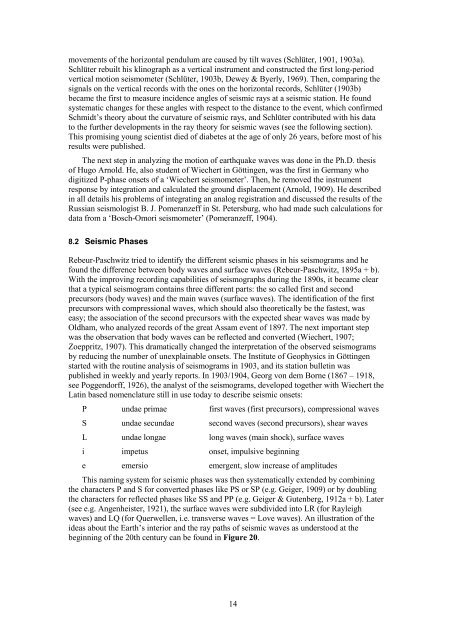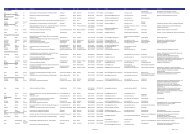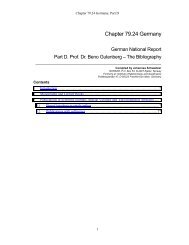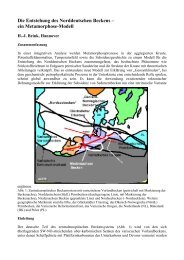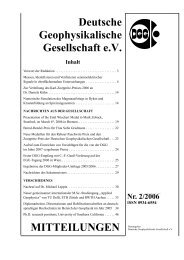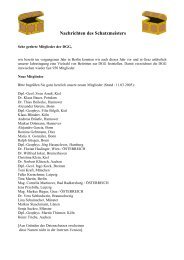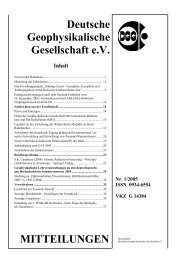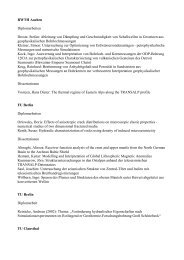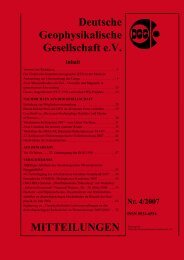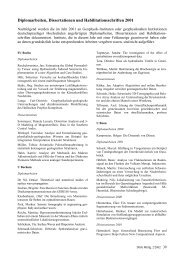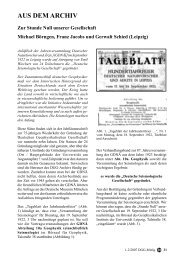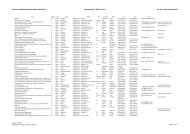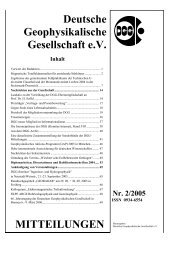Early Contributions to Modern Seismology - Deutsche ...
Early Contributions to Modern Seismology - Deutsche ...
Early Contributions to Modern Seismology - Deutsche ...
Create successful ePaper yourself
Turn your PDF publications into a flip-book with our unique Google optimized e-Paper software.
movements of the horizontal pendulum are caused by tilt waves (Schlüter, 1901, 1903a).<br />
Schlüter rebuilt his klinograph as a vertical instrument and constructed the first long-period<br />
vertical motion seismometer (Schlüter, 1903b, Dewey & Byerly, 1969). Then, comparing the<br />
signals on the vertical records with the ones on the horizontal records, Schlüter (1903b)<br />
became the first <strong>to</strong> measure incidence angles of seismic rays at a seismic station. He found<br />
systematic changes for these angles with respect <strong>to</strong> the distance <strong>to</strong> the event, which confirmed<br />
Schmidt’s theory about the curvature of seismic rays, and Schlüter contributed with his data<br />
<strong>to</strong> the further developments in the ray theory for seismic waves (see the following section).<br />
This promising young scientist died of diabetes at the age of only 26 years, before most of his<br />
results were published.<br />
The next step in analyzing the motion of earthquake waves was done in the Ph.D. thesis<br />
of Hugo Arnold. He, also student of Wiechert in Göttingen, was the first in Germany who<br />
digitized P-phase onsets of a ‘Wiechert seismometer’. Then, he removed the instrument<br />
response by integration and calculated the ground displacement (Arnold, 1909). He described<br />
in all details his problems of integrating an analog registration and discussed the results of the<br />
Russian seismologist B. J. Pomeranzeff in St. Petersburg, who had made such calculations for<br />
data from a ‘Bosch-Omori seismometer’ (Pomeranzeff, 1904).<br />
8.2 Seismic Phases<br />
Rebeur-Paschwitz tried <strong>to</strong> identify the different seismic phases in his seismograms and he<br />
found the difference between body waves and surface waves (Rebeur-Paschwitz, 1895a + b).<br />
With the improving recording capabilities of seismographs during the 1890s, it became clear<br />
that a typical seismogram contains three different parts: the so called first and second<br />
precursors (body waves) and the main waves (surface waves). The identification of the first<br />
precursors with compressional waves, which should also theoretically be the fastest, was<br />
easy; the association of the second precursors with the expected shear waves was made by<br />
Oldham, who analyzed records of the great Assam event of 1897. The next important step<br />
was the observation that body waves can be reflected and converted (Wiechert, 1907;<br />
Zoeppritz, 1907). This dramatically changed the interpretation of the observed seismograms<br />
by reducing the number of unexplainable onsets. The Institute of Geophysics in Göttingen<br />
started with the routine analysis of seismograms in 1903, and its station bulletin was<br />
published in weekly and yearly reports. In 1903/1904, Georg von dem Borne (1867 – 1918,<br />
see Poggendorff, 1926), the analyst of the seismograms, developed <strong>to</strong>gether with Wiechert the<br />
Latin based nomenclature still in use <strong>to</strong>day <strong>to</strong> describe seismic onsets:<br />
P undae primae first waves (first precursors), compressional waves<br />
S undae secundae second waves (second precursors), shear waves<br />
L undae longae long waves (main shock), surface waves<br />
i impetus onset, impulsive beginning<br />
e emersio emergent, slow increase of amplitudes<br />
This naming system for seismic phases was then systematically extended by combining<br />
the characters P and S for converted phases like PS or SP (e.g. Geiger, 1909) or by doubling<br />
the characters for reflected phases like SS and PP (e.g. Geiger & Gutenberg, 1912a + b). Later<br />
(see e.g. Angenheister, 1921), the surface waves were subdivided in<strong>to</strong> LR (for Rayleigh<br />
waves) and LQ (for Querwellen, i.e. transverse waves = Love waves). An illustration of the<br />
ideas about the Earth’s interior and the ray paths of seismic waves as unders<strong>to</strong>od at the<br />
beginning of the 20th century can be found in Figure 20.<br />
14


